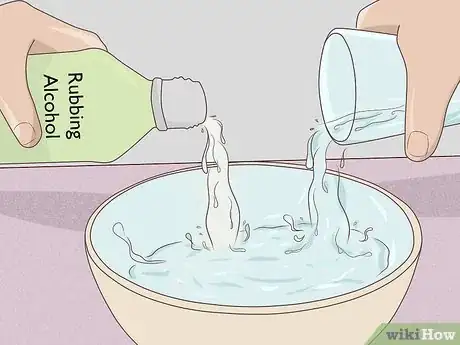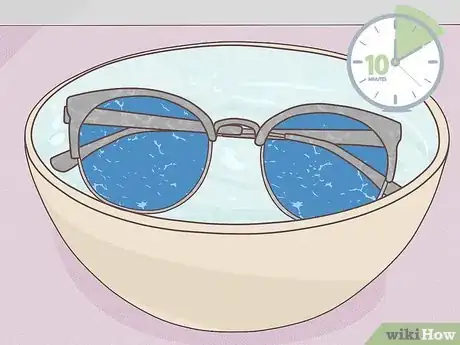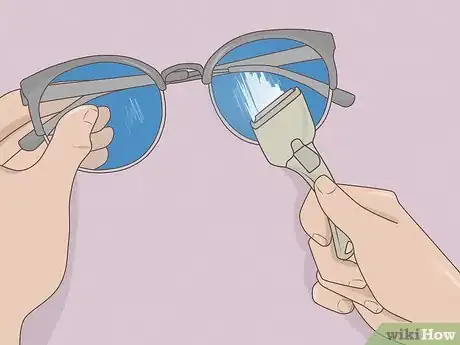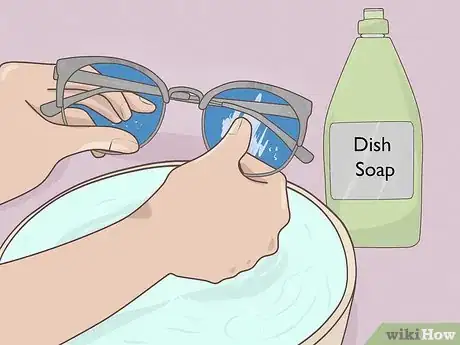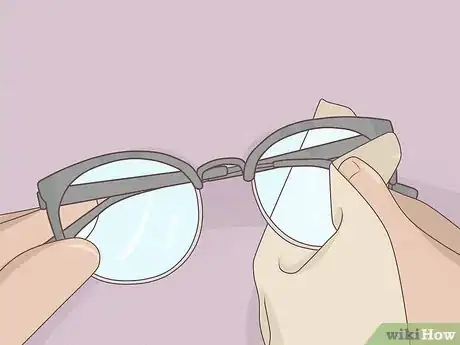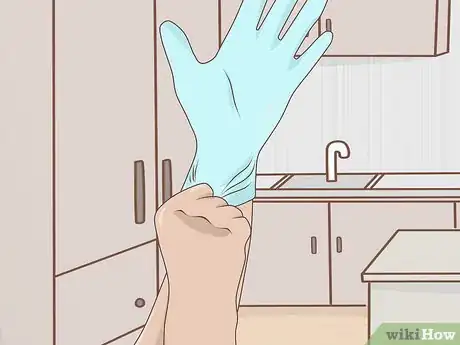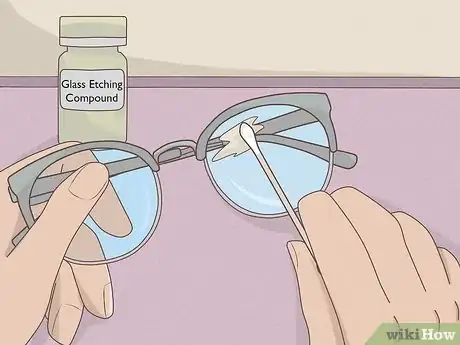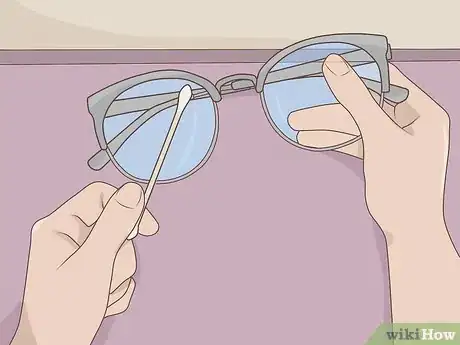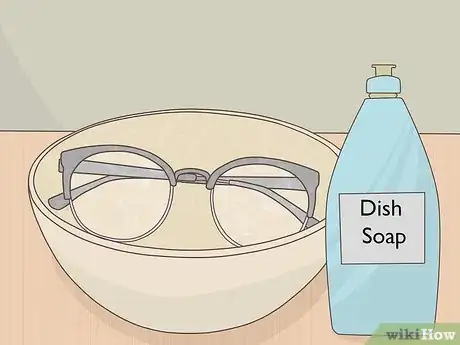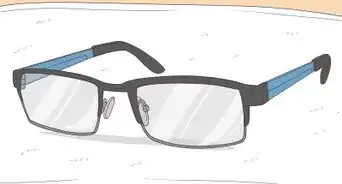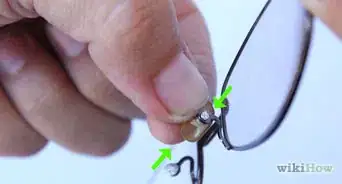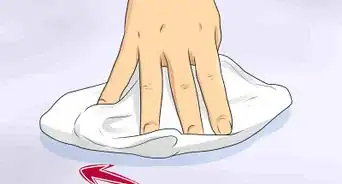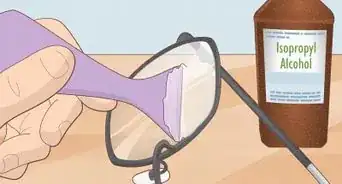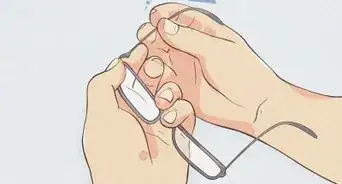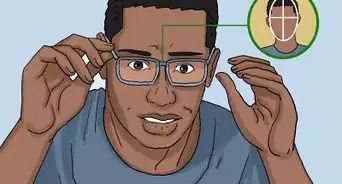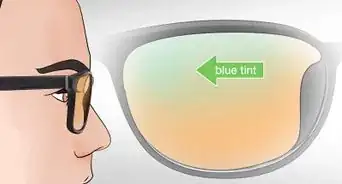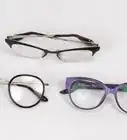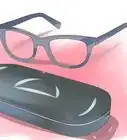This article was co-authored by wikiHow Staff. Our trained team of editors and researchers validate articles for accuracy and comprehensiveness. wikiHow's Content Management Team carefully monitors the work from our editorial staff to ensure that each article is backed by trusted research and meets our high quality standards.
This article has been viewed 86,080 times.
Learn more...
The tint on your glasses is made by a special coating on the lenses, and over time, the coating can get scratched, which can impair your vision. You may also just want glasses that don’t have a tint on the lenses. Either way, removing the tint is actually really easy to do, but the process is different depending on whether you have glass or plastic lenses. If you’re unsure if you have glass or plastic lenses, cover a lens with a paper towel and gently tap on it with your fingernail. If it makes a dull sound, then they’re plastic, and if they "ting" like a wine glass, then they’re glass.
Steps
Scraping the Coating off of Glass Lenses
-
1Fill a bowl with 90% rubbing alcohol and 10% water. Use a clean, medium-sized bowl that is large enough to fit your glasses. Fill the bowl with rubbing alcohol, also known as isopropyl alcohol, and then add a small amount of water to dilute it. Use a spoon to stir the mixture so it’s fully combined.[1]
- You can find rubbing alcohol at department stores or by ordering it online.
- Rubbing alcohol can put off noxious fumes, so don’t lean directly over it as you pour it into the bowl to avoid inhaling them.
-
2Soak the glasses in rubbing alcohol for about 10 minutes. Place your glasses into the solution so they’re fully submerged below the surface. If they float to the surface, place a spoon or another utensil on top of them to help hold them down. Leave the glasses undisturbed for about 10 minutes and then remove them from the bowl.[2]
- The rubbing alcohol won’t damage the frame or the hinges on your glasses.
Advertisement -
3Use a plastic stove scraper to scrape off the coating from the lenses. A stove scraper, also known as a cooktop scraper or a range cleaner, is a flat piece of plastic designed to remove debris that’s stuck on a stovetop. Hold the glasses in 1 hand and use your other hand to gently rub the surface of the lenses with the flat edge of the scraper. Remove the coating from both sides of both lenses.[3]
- There will be a pile of flakes that form as the coating is removed.
- Scrape the edge at an angle so you don’t scratch the lenses themselves.
-
4Clean the lenses with soap and water to remove the flakes. Once you’ve scraped off the coating, fill a clean, medium-sized bowl with about 2 cups (470 mL) of warm water. Add about 1 teaspoon (4.9 mL) of a mild dish soap into the water and mix the solution well so it’s nice and soapy. Place your glasses in the solution and use your fingers to rub the lenses and remove the flaky buildup.[4]
- Be sure to rub the edges where the frames meet the lenses to remove the flakes that collect in the crack.
-
5Wipe the lenses with a clean, dry cloth. Take the lenses out of the bowl once they’re nice and clean and use a clean dry cloth to gently wipe them down to dry them off and to remove any lingering bits of the flaky coating. Dry off the lenses and the frames so you can start wearing your new, tint-free glasses.[5]
Tip: If some of the coating still remains on the lenses after you dry off the glasses, repeat the process again, but leave the glasses to soak in the alcohol solution for 30 minutes instead of 10.
Wiping the Coating off of Plastic Lenses
-
1Wear rubber gloves when you’re using glass etching compound. Glass etching compound is a cream that contains hydrofluoric and sulfuric acid and is designed to create designs on glass, but it will also eat away the protective coating on your lenses. The acid in the glass etching compound is highly corrosive and can burn or damage your skin if it comes into contact with it, so put on a pair of well-fitting rubber gloves to protect your hands.[6]
- Latex or rubber cleaning gloves will work just fine.
- You can find glass etching compound at hardware stores, art supply stores, or by ordering some online.
-
2Use a cotton swab to apply the compound to the plastic lenses. Take a clean cotton swab and dip 1 end into the bottle of the compound. Spread the compound to form an even layer over both sides of both lenses.[7]
Warning: If you do get some of the compound on your skin, wash the area immediately with soap and water to prevent burns.
-
3Wipe off any of the compound on the lenses with a clean cotton swab. The glass etching compound can potentially damage or discolor your frames, so once you apply a layer over the lenses, take a clean cotton swab and use it to wipe off any of the compound that got onto the frame. Rub the areas around the lenses so they’re clean and clear and the compound is only on the lenses.[8]
- If you don’t have any cotton swabs, you can use dry paper towels.
-
4Let the etching compound sit for about 5 minutes. Place the glasses on a flat surface so the lenses aren’t touching anything. Leave them undisturbed for about 5 minutes to allow the acids in the compound to remove the coating from the surface of the lenses.[9]
- Read the directions on the packaging of the glass etching compound for specific wait times. If the bottle says to wait 10 minutes, then wait for 10 instead of 5.
-
5Rub the lenses with a microfiber cloth to remove the coating. Use a microfiber cloth so you don’t scratch the surface of the lenses. Hold the glasses in 1 hand and use your other hand to hold the cloth and gently rub the lenses using consistent, circular motions to remove the compound as well as the coating from them.[10]
- Wipe down both sides of both lenses.
- You may get some of the compound on the frame as you rub the lenses, so run the cloth over it as soon as you’re finished to pick up any compound that may be on it.
-
6Clean the lenses with dish soap and water to rinse off the compound. Once you’ve removed the glass etching compound, fill a clean medium-sized bowl with 2 cups (470 mL) of warm water and add a few drops of a mild dish soap. Mix the solution to make it nice and soapy and submerge your glasses into it. Use your fingers to rub off any remaining bits of coating and compound. Rinse away the soap with clean water and dry off the glasses with a clean dry cloth.[11]
Warnings
- Wash the affected area immediately with soap and warm water if you get any glass etching compound on your skin.⧼thumbs_response⧽
Things You’ll Need
Scraping the Coating off of Glass Lenses
- Rubbing alcohol
- Medium-sized bowl
- Plastic stove scraper
- Mild dish soap
- Clean cloth
Wiping the Coating off of Plastic Lenses
- Rubber gloves
- Glass etching compound
- Microfiber cloth
- Cotton swabs
- Medium-sized bowl
- Dish soap
- Clean cloth
References
- ↑ https://sciencing.com/remove-antireflective-coating-eyeglasses-7631108.html
- ↑ https://youtu.be/qVaaTlujP6I?t=13
- ↑ https://sciencing.com/remove-antireflective-coating-eyeglasses-7631108.html
- ↑ https://sciencing.com/remove-antireflective-coating-eyeglasses-7631108.html
- ↑ https://sciencing.com/remove-antireflective-coating-eyeglasses-7631108.html
- ↑ http://edhoy.com/wp-content/uploads/msds/5303_53003_53004_msds.pdf
- ↑ https://youtu.be/pA9MLnH9qs0?t=35
- ↑ https://youtu.be/pA9MLnH9qs0?t=82
- ↑ https://sciencing.com/remove-antireflective-coating-eyeglasses-7631108.html
